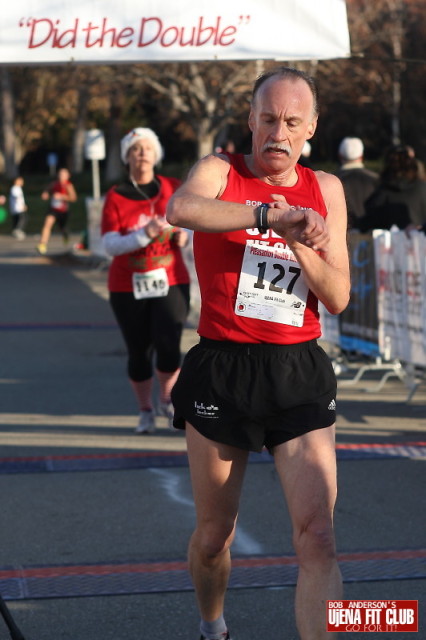UjENA FIT Club 100 Interesting Running Articles
Best Road Races and the UjENA FIT Club is publishing 100 articles about races, training, diet, shoes and coaching. If you would like to contribute to this feature, send an email to Bob Anderson at bob@ujena.com . We are looking for cutting edge material.
Click here to read all Running Articles
Posted Wednesday, February 11th, 2015
By David Prokop Pleasanton, Calif., may be a quiet, relaxed community across the bay from San Francisco, but where Double... Read Article
Posted Monday, September 15th, 2014
Peter Mullin has taken Double Racing® by storm. He broke the 60-64 age group world record in the first Double... Read Article
Posted Monday, September 22nd, 2014
by David Prokop (Editor Best Road Races) Photo: Double 15k top three Double Racing® is a new sport for... Read Article
Posted Sunday, May 11th, 2014
By David Prokop, editor Best Road Races The world’s most unusual race met the world’s most beautiful place, in the... Read Article
DO YOU DOUBLE?
Monday, January 13th, 2014
The new kid on the road-racing block, the Double Road Race is making a big impact on the American running scene.
By David Prokop (Editor, Best Road Races) It is Sunday morning, Dec. 22, 2013 in the attractive San Francisco Bay area community of Pleasanton, Calif. Runners from near and far have gathered for the second annual Pleasanton Double Road Race™, a unique new running competition which made its world debut almost exactly a year earlier at this very site. The one who has come the farthest to be here is Julius Koskei, a 31-year-old, have-shoes, will-travel professional distance runner from Nyaharuru, Kenya who holds the world record in the Double Road Race™. He makes his living doing this – running! – and a pretty darn good one, which means he’s rather good at it. You try to earn a living and support a family of four off the prize money you win at road races! Or would a desk job somewhere seem a little easier and more appealing?
Photo: Julius Koskei running the 10k leg under 30 minutes. At the other end of the running spectrum from an athlete like this, and making up the bulk of the field this morning, are hundreds of local area runners of more modest ability levels, all of these competitors joined by the one common denominator: a passion for running! Why else would they be standing at the starting line, shivering in light running gear, at 8:15 on a frigid California morning three days before Christmas? Having paid good money, moreover, as an entry fee to try what has been called the Next Dimension in Racing – the Double Road Race™. Today these runners will go through a kind of running expedition/exploration where they will first run a 10-kilometer leg or segment, against other competitors but mainly against the clock and therefore themselves. Then they will have a recovery break of approximately an hour, spent in an area called the Recovery Zone, where they’ll be able to avail themselves of drinks, nutrition, massage and other recovery therapy techniques – kind of a recovery happy hour! Then they will go back out and run a shorter five-kilometer leg – shorter, yes, but not necessarily easier, indeed almost certainly not easier, because now they’ll be more tired, having already run a 10K, normally a full day’s work in a normal race!
The one who’s put these two segments together best going into the second annual Pleasanton Double is Julius Koskei (pronounced Kos-kay), who ran the 10K in the Indianapolis Double earlier in the year in 29:48 (most people in today’s race couldn’t move that fast unless they were riding a bicycle), then coming back to run the 5K in 14:43, giving him an aggregate time of 44:31:09. World record! Clearly, Julius Koskei doesn’t need a bicycle. The way he can motor in a road race, a bike might even slow him down! Going into this morning’s race, seven Doubles have been held in the U.S. thus far and one in Greece. No one else has run as fast as Koskei. In fact, no one has come within 17 seconds of his time! It is the presence of runners like Koskei and other elite athletes like him which makes the Double a world-class event, but if there’s any running competition which has an endless array of facets to it that also makes it a family fun event, it’s the Double. For the Double is not only a physical challenge, but a strategic puzzle to solve and a mind game to master. All races are, but the Double is even more so. Hey, there’s even a recovery break in between – who ever heard of a race with a halftime?
The race for first is at the front, obviously. The heart of the race is in the middle, where serious runners, tried and true, strive to do their best, race against their peers, improve on their previous best aggregate time. The soul of the race, however, is found at the rear. For it is the courageous and worthy runners at the tail end of the field who operate on the limit, at the edge, of whether they’ll even be able to last the distance. Just like in the marathon the champions at the front really have no doubts whether they can finish the race – goodness knows some of these human greyhounds run almost the equivalent of a marathon in training every day! – the same thing applies in the Double. Therefore, it can be said that the real test of will and perseverance out there on the roads in the marathon – as well as in the Double Road Race™ -- is waged mostly by those in the middle and back of the field who are out there to first finish, not to finish first. Those who are out there for the joy of participating, for the discovery of self, for the feeling they get from knowing they pushed themselves further than before, and will have the concomitant endorphin rush and self-pride that comes from knowing they actually finished something they weren’t even sure they could.
Compared to the Double, a regular race is very simplistic. The gun goes off, you run from the start to the finish, you finish however you finish (place and time), that’s it! The Double is different. It may indeed be true that as Bob Anderson, the creator of the Double, says, “The Double is the only race with a halftime,” which is a break you have to take, incidentally, even if you didn’t want to, but the Double is, above all else, a process! A process in which you have to put three elements together properly – 10K, recovery period, 5K. In that regard, running a Double is akin to climbing a very tall mountain. Let’s use Mt. Everest as an example. No one goes from the base of Everest to the summit in a single, uninterrupted effort – as you might if you were climbing a smaller peak. You climb Everest in stages, it’s a process, an elaborate one. The Double, likewise, is a process. With all kinds of strategic and pacing/recovery considerations thrown in. It is an ingenious Rubic’s Cube of a running challenge that you have a chance to work through – like an elaborate puzzle which features running as the core activity, and strategy, stamina, self-awareness and perseverance as the tools you use.
Anyone old enough might remember those little trinkets we used to find as kids when we opened a box of Cracker Jack? The Double offers a hidden prize, too, especially for competitors who may not have run a race before. For a newcomer, running a race like the half-marathon or marathon for the first time may be a daunting, even frightening challenge. After all, when that gun goes off, you have to run from start to finish. There’s no time to take a rest, get any kind of treatment or therapy en route, etc. The Double, on the other hand, which may seem at first glance like it involves running two races in one day (not a comforting thought), but in fact, it’s one race with two legs or segments, gives you the unprecedented opportunity to run a race with a rest built in (now that is a comforting thought!). Therefore, you can sort of “feel” your way through the race, so to speak, which can be a very important physical and psychological benefit to someone who’s never run a race before. Voila, the Next Dimension in Racing becomes the Humane Approach to Racing! Furthermore, if you should happen to run into any number of problems in a half-marathon or marathon – blisters, chafing, an upset stomach, injury – you may have to drop out. And there’s nothing worse in road racing than having to drop out. It ultimately hurts worse mentally than finishing hurts physically, no matter how tired you are! But if you were to encounter the same problems in the Double, however, you might be able to get appropriate treatment during the recovery break, which could very well enable you to finish the race and experience the “joy of victory” rather than the “agony of defeat,” in the words of that long-ago, unforgettable intro to ABC ’s Wide World of Sports on television. Comments and Feedback
 All Double runners need to read this article by David Prokop...San Jose Double is coming up Feb 22! All Double runners need to read this article by David Prokop...San Jose Double is coming up Feb 22!Bob Anderson 1/13/14 4:07 pm |
,,,,, | Certainly, any beginning runner planning to run a half-marathon for the first time would be well advised to run the Double Road Race™ first, because it’s shorter than a half-marathon, yet more physically and perhaps psychologically demanding, and participants get that all-important, welcome rest in between. Doesn’t that seem like a perfect way for someone to prepare for his or her first half-marathon – and even the marathon itself? Plus, competing in a Double teaches competitors invaluable lessons about pacing, energy conservation and perseverance, all of which is applicable to running any other kind of distance race. The long and short of it is that the Double is a race of heretofore unheard of nuance, of strategy choices, of self-awareness and endurance refinement. A thinking runner’s event. As veteran runner Bill Dunn, who won the 65-69 age group in the inaugural Pleasanton Double in December of 2012, said, “I like the fact it’s a cerebral event, not just a physical event.”
Photo: The Double is attracting many good sixty plus runners. Bob Anderson (101) with 73-year-old Hans (132) and Ron (719) Remember, Bob Anderson, who created the Double, runs a lot of races and has been doing so for years. Indeed he’s something of a racing addict. In 2012 alone – the year he unveiled the Double Road Race™ on the American running scene – he ran 50 races to celebrate his 50 years as a runner. Therefore, when he concluded that runners (especially those who run a lot of races) needed something different and the Double would fit the bill to a T, one might be inclined to give him the benefit of the doubt that they did and it does. This is a man, after all, whose creative bent gave us Runner’s World, the magazine he founded as a high school senior and published for 18 years until he sold it in 1984 when the circulation had reached 450,000. In addition to that, he also created innovative running events such as the 24-Hour Relay, where teams of anywhere from two to 10 runners would run alternate miles for 24 hours, and the Corporate Cup Relays, which became a very prominent competition in the running boom years of the early ‘80s as corporations were encouraged to enter staff relay teams in a corporate track meet held in a stadium. Creativity, especially when it comes to running, is part of Bob Anderson’s nature, and the Double Road Race™ is only the latest, yet perhaps the most dramatic, example of it. For this time he’s created something so new and innovative, it can be called a new sport (and he does call it that) – the sport of Double Road Racing – alongside sports like Triathlon and Orienteering. It’s an event that literally has something for everyone – from the fastest to the slowest. The fastest, Julius Koskei, has said of the Double: ““This is a very good race, I love it! When you finish the 10K and you have to recover, you know you still have 5K to run. When you run the 5K, that pain (of recovery) is gone. And when you finish (the 5K), you feel better than if you just ran one race. (The feeling of accomplishment) is almost like you ran a marathon.” Back to the beginning: On Sun., Dec. 22, 2013, as the time ticks down to the 8:15 a.m. start of the 10K at the second annual Pleasanton Double, there’s frost on the grass, the warming sun is still hiding behind the eastern horizon, and the temperature is freezing cold. Julius Koskei from Kenya must feel like Sam McGee in the famous Robert Service poem, The Cremation of Sam McGee, set in the snowy Yukon – remember the memorable line, ”Why Sam left his home in the South to roam round the Pole, God only knows?” Everyone shivers through a rendition of the national anthem. Then, with the high-pitched blare of a starting horn, Pleasanton mayor Jerry Thorne sends the assembled runners off on the opening leg of their 10K-5K journey.
Photo: Julius and Tesfaye battling during the first four miles of the 10k leg Koskei and two other Africans – his countryman Charles Matheri and Ethiopia’s Tesfaye Alemayehu, who now lives in Antioch, Calif., near Oakland – shoot out in front. The rest of the field follows and fans out on the road behind them. No one else tries to match the early pace of the three Africans. Koskei, the only man who has ever run under 30 minutes in the 10K of the Double, has said beforehand that he’ll try to run the 10K today in 29 minutes flat! That would translate to 4:40 per mile pace! But within a mile into the race, he decides it’s too cold and his body too stiff for him to attempt such a lofty goal this day. He doesn’t run well in the cold, he has said. Runs well enough though. At two miles Matheri drops off the pace. Now it’s only Koskei and Alemeyehu at the front. At the end of the first lap of the two-lap course that makes up the 10K, Koskei is forcing the pace, the taller Alemeyehu gliding along behind him but looking under duress. A mile later, at four miles, the Ethiopian is forced to yield, his right thigh stiffening up as it had when he had been forced to drop out of the California International Marathon in Sacramento two weeks earlier. Julius Koskei goes on alone to run the 10K in 29:42, three seconds faster than he had run at Indianapolis when he set the world record. Alemeyehu finishes 44 seconds behind him in 30:26.
Behind these leaders, the masses that make up the heart and soul of the race come streaming to the finish line of the 10K – singly, in pairs, or even larger groups. The Recovery Zone awaits, a time for refueling, regrouping, refocusing and then going back out on the road and doing it all over again – at half the distance – to complete the process and finish the race. The Recovery Zone is a place to compare notes with fellow runners, stay loose, get something to eat and drink, correct anything in your approach needing correction, or just concentrating on doing more of the same if the 10K went totally to your satisfaction.
By the start of the 5K at Pleasanton, the sun is beaming down brightly, the temperature has risen to a balmy 70 degrees and the runners, including Julius Koskei from equatorial Africa, are stripped down to their skivvies for the 5K run to the finish of the Double. He has a new world record awaiting him if he can run the 5K fast enough. Knowing he has to push hard to ensure he gets the new record (no one in the Double, no matter how fit, knows exactly how his or her legs will react in the 5K), Koskei bolts off the line when the runners are sent on their way. Alemeyehu is the only one who goes with him – and he will stay with Koskei for 1½ miles before he has to back off again, lest he severely injure his right leg. Koskei drives onward, pushing himself on his own, unsparingly – for him this is now strictly a race against time. He has laid the foundation for a new world record, now he must go for the summit! And when he rounds the final turn leading into the short finishing straight and crosses the finish line in 14:35, he has indeed set still another world record, his aggregate time of 44:24:01 bettering the time he set at Indianapolis by seven seconds! A quiet-spoken, 5’5”, 125-pound runner, Koskei has reckoned that under ideal weather conditions and at his very best he could run 28:50 for the 10K and 14:10 for the 5K of the Double – in other words, an aggregate time of 43:30! But he and the running world will have to wait another day to see such an achievement.
Photo: Peter Mullins set a new 60-69 age group world best. He ran 55:55. On this no less memorable day, the victor has crossed the finish line, the world record has been broken, but the race goes on – until all who run have finished their journey, this process that is the Double. Each competitor a winner in his or her own way. For in any distance race there are countless winners – and certainly everyone who finishes can’t be called anything but a winner. Chantelle Wilder, a Canadian now living in Los Gatos, Calif., wins the women’s division in the second annual Pleasanton Double, running the 10K in 36:13:21 and the 5K in 17:40 for an aggregate time of 53:53:21. No fewer than six age-group world records are set in the race – Julius Koskei, Kenya, 30-39 age group (44:24), Alan Reynolds, Sausalito, Calif., 50-59 age group (52:51:55); Peter Mullin, Houston, Tex., 60-69 age group (55:55:95); Natalie Dimits, Livermore, Calif., women’s 19 and under age group (57:23:06), Sharlet Gilbert, Richmond, Calif., women’s 60-65 age group (1:07:22); and Melody-Anne Schultz, Ross, Calif., women’s 70 and over age group (1:13:29).
Photo: Bob with running friends Jan and Bill. Bob Anderson, who dreamt up this unique new running challenge, is there in Pleasanton (he’s always there wherever and whenever a Double is staged; in fact, he’s the only one who has run all of them), and he finishes second in the 65-69 age group. Afterwards he says, like a proud parent, that in his estimation the big story at Pleasanton isn’t that Julius Koskei improved on his own world record (impressive as that was), but that the second annual Pleasanton Double was the best Double ever run – and no one seeing all the runners in the Double and the other two races on the program (the Christmas 5K and the Kids’ Cup One-Mile) so thoroughly and exuberantly enjoying themselves would disagree with him. Certainly, the second annual Pleasanton Double was such an exciting, competitive, social and enjoyable running event, it’s clear the Double Road Race™ is gaining momentum and converts – call them “Double afficionados.” One competitor at Pleasanton had never run a Double before, but he enjoyed the competition so much he said afterwards that from now on, he plans to run every Double held in the San Francisco Bay area. Surely, as this sort of phenomenon continues, the Double as an event will move, inexorably, one step closer, another step closer, many steps closer, to the time when fellow runners will walk up to you (assuming you’re a runner) and ask, “Do you Double?” |

Copyright 2023 UjENA Swimwear · Site Map · Feedback · Tell A Friend · Nominate a Race
Leaderboard · UjENA 5K · Double Road Race · UjENA Jam · UjENA Network









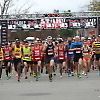

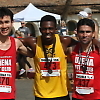

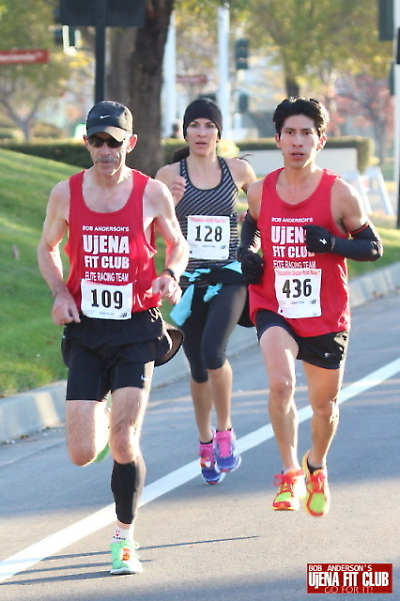

 This is the Double Road Race™ (Double for short) and how these competitors do – against their peers and against themselves – will be determined by aggregate time. What the minutes and seconds are when you add up their 10K and 5K times!
This is the Double Road Race™ (Double for short) and how these competitors do – against their peers and against themselves – will be determined by aggregate time. What the minutes and seconds are when you add up their 10K and 5K times! 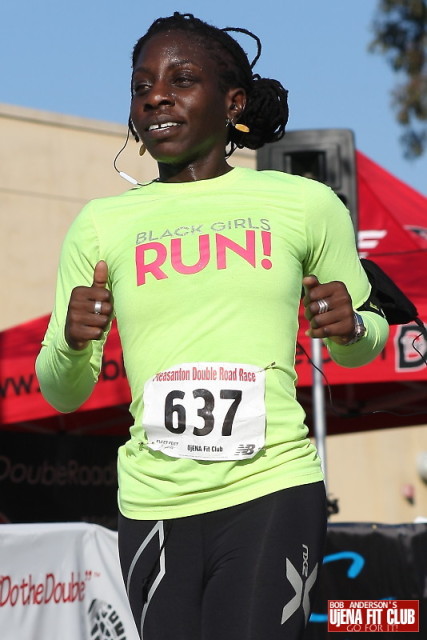
 In the Double, however, finishing perhaps isn’t the primary challenge, although many participants say finishing is no small feat, that the Double is at least as hard as a half-marathon, if not harder, despite the fact the total distance is shorter, only 15K (that’s three miles shorter than the half-marathon), and that the recovery break, ironically, makes the Double harder than running a straight 15K! Why? Because you have to warm down, then warm up all over again, do all the necessary things to make sure your body doesn’t stiffen up during the break, eat and drink enough but not too much, etc. Which brings us to the prime point: The bigger challenge in the Double – and part of the fun and the addictive quality of the event – is combining everything the most effectively, i.e., running the 10K leg and 5K leg at the right pace and using the recovery time wisely.
In the Double, however, finishing perhaps isn’t the primary challenge, although many participants say finishing is no small feat, that the Double is at least as hard as a half-marathon, if not harder, despite the fact the total distance is shorter, only 15K (that’s three miles shorter than the half-marathon), and that the recovery break, ironically, makes the Double harder than running a straight 15K! Why? Because you have to warm down, then warm up all over again, do all the necessary things to make sure your body doesn’t stiffen up during the break, eat and drink enough but not too much, etc. Which brings us to the prime point: The bigger challenge in the Double – and part of the fun and the addictive quality of the event – is combining everything the most effectively, i.e., running the 10K leg and 5K leg at the right pace and using the recovery time wisely. The Double has been called a runner’s chess match on the roads in shoes, shorts and a singlet. In the Double you don’t have to crudely crucify yourself in the 10K and 5K, run back to back as they are. Rather you can combine endurance, tactics and smarts to do well, indeed you have to in order to do your best because pacing and tactics are hugely important in the Double. The planning and execution of the three stages – 10K, recovery, 5K – is what’s paramount. Not brute strength, not where you actually finish in the 10K or 5K, not who you “beat,” but how you do overall, on cumulative time. That’s the key. That’s ultimately how you “keep score” in the Double.
The Double has been called a runner’s chess match on the roads in shoes, shorts and a singlet. In the Double you don’t have to crudely crucify yourself in the 10K and 5K, run back to back as they are. Rather you can combine endurance, tactics and smarts to do well, indeed you have to in order to do your best because pacing and tactics are hugely important in the Double. The planning and execution of the three stages – 10K, recovery, 5K – is what’s paramount. Not brute strength, not where you actually finish in the 10K or 5K, not who you “beat,” but how you do overall, on cumulative time. That’s the key. That’s ultimately how you “keep score” in the Double. 

 The Kenyan is now assured of victory if he runs the 5K in anything approaching a respectable time for him, but will he break his world record? To do that, he needs to run the 5K in 14:46 or better. Remember, he’s already run a hard 10K.
The Kenyan is now assured of victory if he runs the 5K in anything approaching a respectable time for him, but will he break his world record? To do that, he needs to run the 5K in 14:46 or better. Remember, he’s already run a hard 10K. This then is the Double – there’s nothing else in running to compare with it. Certainly there’s nothing to compare with the Recovery Zone. And in only one short year since the Double made it’s debut on the American and world running scene, it has laid a solid foundation, created a sincere and enthusiastic following, and truly added something physically and mentally new to road racing.
This then is the Double – there’s nothing else in running to compare with it. Certainly there’s nothing to compare with the Recovery Zone. And in only one short year since the Double made it’s debut on the American and world running scene, it has laid a solid foundation, created a sincere and enthusiastic following, and truly added something physically and mentally new to road racing.